Where on the drag strip most ball is ruled Camaro, the Mustang and all sorts of «Muscle cars» are not rare, and «chips» such as this, vaguely reminiscent of its forms are the same Camaro 70th.
These include car and Paul Lowes. Like many others, as a base to build drag-mobile, he decided to use one of the two first subcompact car in the history of the American automobile industry. The first is still considered AMC Gremlin, but it is Vega has become the most common and well known. However, it has earned fame not in a positive sense. And like all good beginning.

From breakthrough …
First you need to explain that in the US until the early 70’s simply not produced like cars. However, competition from Europe and especially Japan, and the emerging energy crisis, caused the so-called «big three» to reflect on the issue of its own subcompact cars. This class was going to be even smaller than compact cars, with a total length of the car hardly exceeds 4 meters.
The first such was already mentioned Gremlin, which was represented by the public as «the first American-built import.»

In the same 1970, but the lineup next year, were presented and Chevrolet Vega c Ford Pinto. Interestingly, just based on the second generation of the legendary Pinto Mustang was built — Ford Mustang II.
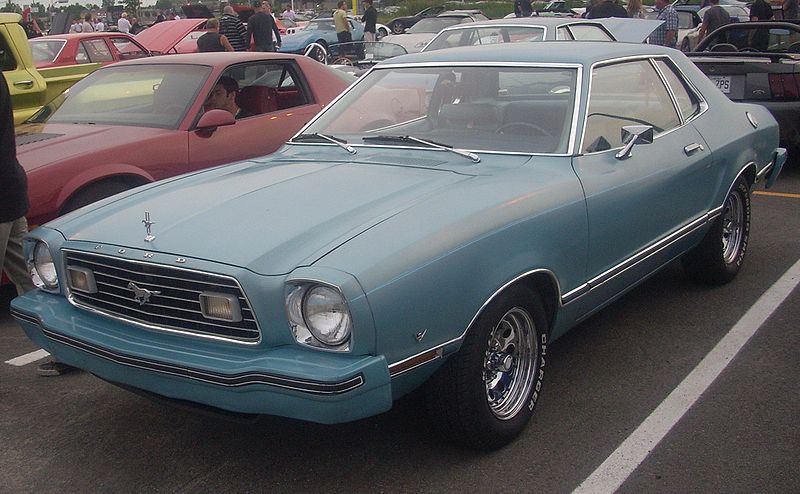
In connection with the fuel crisis of the mid-70s in the Chevrolet Camaro is also planned to stop release. Fortunately, not least thanks to the support already appeared this car fans, it does not suffer the fate of not the most biased based on a subcompact. But on the Vega chassis in the mid-70s produced a separate compact sports model with a bright name of Monza …

But to return to itself the Vega, whose appearance, especially the hood, headlights and grille, in reality is very reminiscent of those years Camaro. Initially, Vega (which received its name from the eponymous star) was designed carefully, as well as its 4-htsillindrovy engine with aluminum cylinder block. By the way for his answer, although in this time more as «most important» supervisory authority, Ed Cole, the man who was head of the group for the creation of the famous «tar-block» the V8 in 1955, the year that brought subsequently considerable dividends Chevrolet.
In terms of the suspension, the Vega left rear beam axle from the familiar to the «live» — with semi-axes, and instead of using archaic spring multi-link suspension and springs on all the «corners».
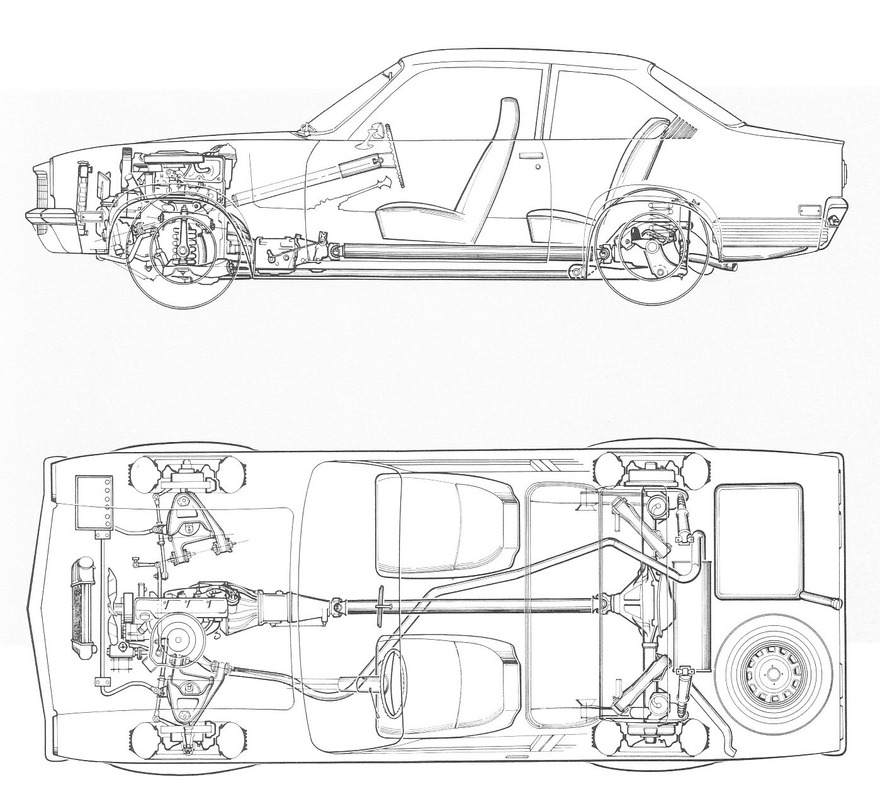
Together with a progressive steering and even more soft front independent suspension, than the Camaro, driveability Vega received only positive feedback, as well as the efficiency of its new engine.
The first such was already mentioned Gremlin, which was represented by the public as «the first American-built import.»

In the same 1970, but the lineup next year, were presented and Chevrolet Vega c Ford Pinto. Interestingly, just based on the second generation of the legendary Pinto Mustang was built — Ford Mustang II.

In connection with the fuel crisis of the mid-70s in the Chevrolet Camaro is also planned to stop release. Fortunately, not least thanks to the support already appeared this car fans, it does not suffer the fate of not the most biased based on a subcompact. But on the Vega chassis in the mid-70s produced a separate compact sports model with a bright name of Monza …

But to return to itself the Vega, whose appearance, especially the hood, headlights and grille, in reality is very reminiscent of those years Camaro. Initially, Vega (which received its name from the eponymous star) was designed carefully, as well as its 4-htsillindrovy engine with aluminum cylinder block. By the way for his answer, although in this time more as «most important» supervisory authority, Ed Cole, the man who was head of the group for the creation of the famous «tar-block» the V8 in 1955, the year that brought subsequently considerable dividends Chevrolet.
In terms of the suspension, the Vega left rear beam axle from the familiar to the «live» — with semi-axes, and instead of using archaic spring multi-link suspension and springs on all the «corners».

Together with a progressive steering and even more soft front independent suspension, than the Camaro, driveability Vega received only positive feedback, as well as the efficiency of its new engine.
At the time, testers and wrote that comfort Vega equated to the usual for «state» «big» cars, while the control corresponded to European standards.
This is not surprising, especially when braking, copied from cars GM European division Opel to face — front disc brakes were effective diameter of 250 mm. Behind remained drum mechanisms, but taking into account the balance of the brakes 70/30 and was more than enough …
Initially it was assumed that for the sake of budget pricing Vega will be very austere. No joke, but it is not only supposed to simple old-fashioned front-seat bench and the absence of any fact that the air conditioner, and even the glove compartment (glove box).
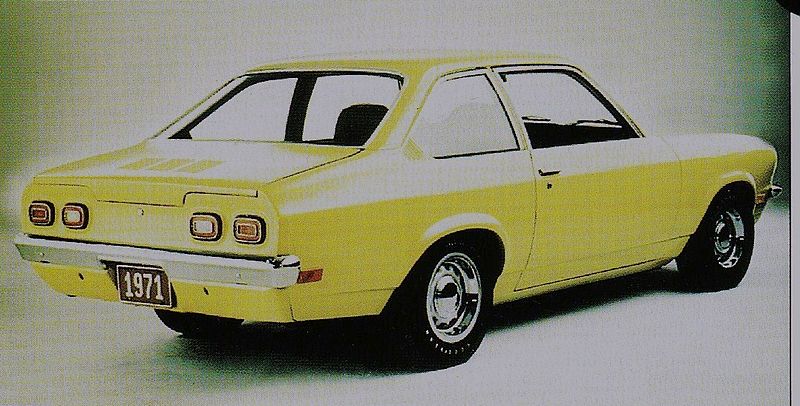
However, as a result of a series has gone much more civilized and comfortable Vega even in the basic version. And from 1972 to Vega in the standard yet appeared «glove box», and together with the two-step «automatic» as an option to offer more advanced turbo-mechanical gidramatichesky «3 stupas» and the various options for a luxury interior trim …
We can not say that the design of Vega favorably differed sportiness and style lines of its Pinto and Gremlin direct competitors.

It is noteworthy that from the first day on the line used computers (and in fact, «the yard» was only the 1970 th year) to check the quality of products. Moreover, «checks» were carried out in many stages of production. But in the end everything went not as planned and bosses wanted GM.
Initially it was assumed that for the sake of budget pricing Vega will be very austere. No joke, but it is not only supposed to simple old-fashioned front-seat bench and the absence of any fact that the air conditioner, and even the glove compartment (glove box).

However, as a result of a series has gone much more civilized and comfortable Vega even in the basic version. And from 1972 to Vega in the standard yet appeared «glove box», and together with the two-step «automatic» as an option to offer more advanced turbo-mechanical gidramatichesky «3 stupas» and the various options for a luxury interior trim …
We can not say that the design of Vega favorably differed sportiness and style lines of its Pinto and Gremlin direct competitors.

It is noteworthy that from the first day on the line used computers (and in fact, «the yard» was only the 1970 th year) to check the quality of products. Moreover, «checks» were carried out in many stages of production. But in the end everything went not as planned and bosses wanted GM.
… To fail!
The history of Vega lay this blot, and not only for the General Motors and Chevrolet in particular, but also for the entire US auto industry as a whole! Still, the rush to please give a budget model, if not before, then at least at the same time competitors — said. Design-engineering, but sea trials has not been canceled. But this phase was badly crumpled.
As the official history of the Vega, the responsible part in preparation for the production of a pre-series models largely given to dealers so to speak, «on trial» customers themselves. It sounds it is, perhaps, a well, but only in theory.
As the official history of the Vega, the responsible part in preparation for the production of a pre-series models largely given to dealers so to speak, «on trial» customers themselves. It sounds it is, perhaps, a well, but only in theory.
Dealers involved in «postscripts», and ordinary drivers not professional testers. Moreover — many «bugs» were still more calculated and constructive.
For example, this has become a byword weak to rust the body, especially the front fenders. Although seemingly applied a lot of measures for anti-corrosion coating including special paint and paint, «baked» at high temperatures, aggregates slots, the same front fenders initially did not even have wing flaps! It is noteworthy that the last planned originally, but greedy (otherwise not tell), economists thought that a small increase to the cost of each machine is too big!
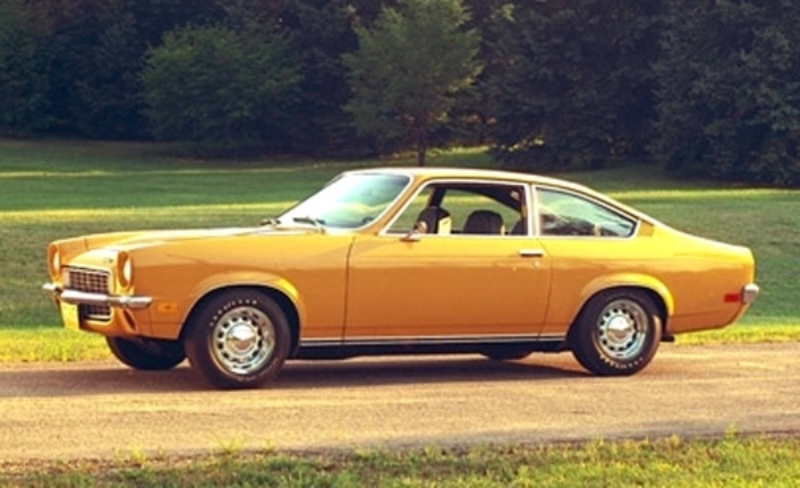
They knew they had — that in the end the company under the guarantee will have to replace many thousands of rusted front fenders, while in general all comments and warranty cases, only one company Vega will spill over into many, many tens of millions of dollars …!
Incidentally full plastic wheel arch liners appeared only in 1974. But the rot and the lower part of the machine, including the door! And only at the very end of the production wings Vega began to perform plated and bottom sides of the body in addition to process zinc-plated special varnishes …

However, the corrosion was only the tip, literally visible to the naked eye, the iceberg of problems Vega.
The new «engine» was also soggy and weak. Partly because of the high, and even a steel cylinder head it featured too much vibration. Again — steel head has been chosen for the sake of budget.

Due to the vibration of the engine very quickly broke down rubber demfiruyuschie elements of its fastening, coolant often fall into the cylinders, and the cooling system itself proved to be ineffective. More precisely, its volume was on the verge and if the driver does not replenish it regularly, the engine began to overheat.
All this led to the failure of the engine, and as it was written later «… Vega engine too easily and too often was prone to self-destruction.» And although later the cooling system capacity slightly increased, in hot states, of which the US lacks, and that was not enough. And all this despite the fact that the engine can run on gasoline low octane and compression it was just the same «Lilliputian» 8.0:1.
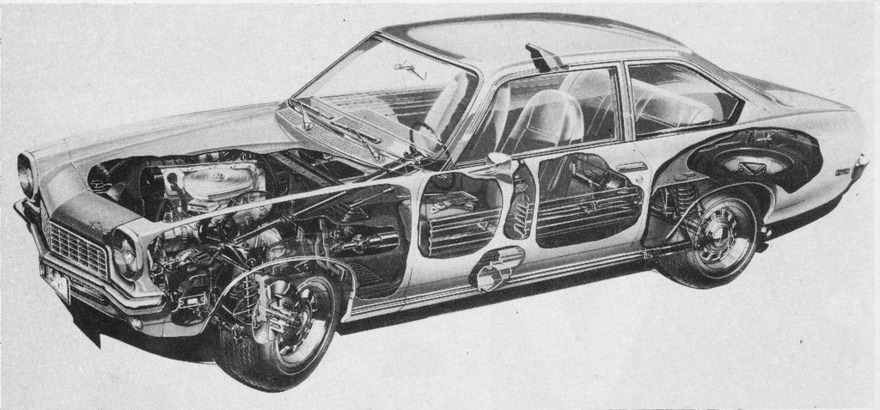
What can I say, if after only a year on the line, to the 72 th lineup changes have been made even in the exhaust and transmission, to reduce them to vibration and noise associated with it … Shock absorbers were also replaced.
According to independent studies 95% of the Vega, issued in the first two years, until May 1972, had a critical problem connected safety. In addition to structural failures and haste in the final stages of pre-production, in part explained by a large number of marriages is also an incredible speed of its production.

They knew they had — that in the end the company under the guarantee will have to replace many thousands of rusted front fenders, while in general all comments and warranty cases, only one company Vega will spill over into many, many tens of millions of dollars …!
Incidentally full plastic wheel arch liners appeared only in 1974. But the rot and the lower part of the machine, including the door! And only at the very end of the production wings Vega began to perform plated and bottom sides of the body in addition to process zinc-plated special varnishes …

However, the corrosion was only the tip, literally visible to the naked eye, the iceberg of problems Vega.
The new «engine» was also soggy and weak. Partly because of the high, and even a steel cylinder head it featured too much vibration. Again — steel head has been chosen for the sake of budget.

Due to the vibration of the engine very quickly broke down rubber demfiruyuschie elements of its fastening, coolant often fall into the cylinders, and the cooling system itself proved to be ineffective. More precisely, its volume was on the verge and if the driver does not replenish it regularly, the engine began to overheat.
All this led to the failure of the engine, and as it was written later «… Vega engine too easily and too often was prone to self-destruction.» And although later the cooling system capacity slightly increased, in hot states, of which the US lacks, and that was not enough. And all this despite the fact that the engine can run on gasoline low octane and compression it was just the same «Lilliputian» 8.0:1.

What can I say, if after only a year on the line, to the 72 th lineup changes have been made even in the exhaust and transmission, to reduce them to vibration and noise associated with it … Shock absorbers were also replaced.
According to independent studies 95% of the Vega, issued in the first two years, until May 1972, had a critical problem connected safety. In addition to structural failures and haste in the final stages of pre-production, in part explained by a large number of marriages is also an incredible speed of its production.
Quantity, not quality
Especially for Vega in the village of Lordstown was equipped with a new plant, which cost GM $ 75 million — the money at the time astronomical. On assurances of the group, it was the most automated in the world at that time — 95% of spot welds and seams (from 3900 in each body) is carried out automatically by robots.
The so-called «wedding» — the combination of the body with the engine and transmission — carried by a large hydraulic jacks, while all other assembly lines used conveyors.
All this was done in order to achieve the release of 100 Vega … no, not in one day, and in one hour! In other words, every 36 seconds off the assembly line had to go to a brand new car. This is higher than exactly twice breakthrough performance in the world at that time. Already during the first few months it has been achieved in the figures 73,5 Vega hour. In part, the speed achieved using the fourth working rotation where it was necessary three — in one operation «extra» rested.
Soon conveyor closer to the coveted hundred. However, at 85 units per hour, began to have serious problems with the capacity of paint and paint shop.
However, together with the manufacturer DuPont, as well as changes in the structure of coloring nozzles produce a new quick-drying primer and paint, the problems were solved. But then again it affected the desire to save!
GM bosses not only strengthened discipline sinning at work, but after the change of management structure was abolished that same «fourth», reducing to 800 people. This leadership has accused the workers not only in slowing down the work, but even sabotage.
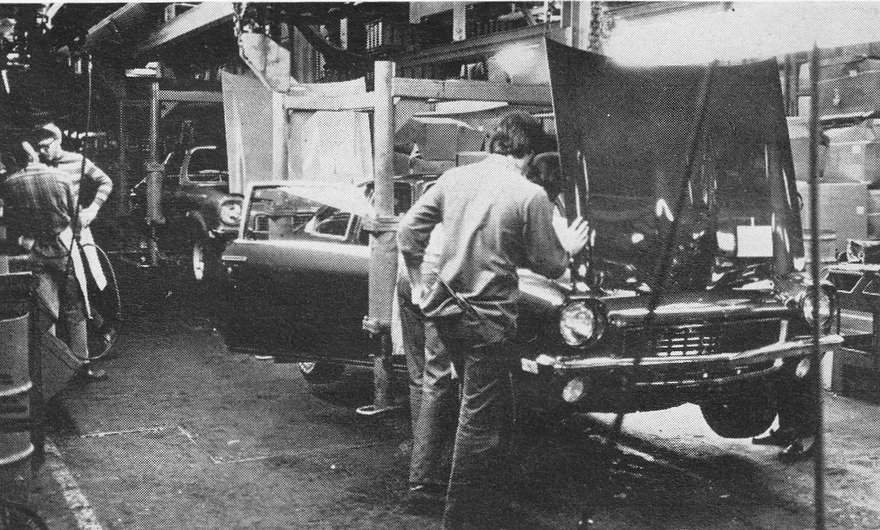
As a result, nearly 8000 workers in March 1972, went on strike, and not agreed with the unions, and spontaneous — so much they «get» the capitalists. The strike lasted for a month and cost GM twice more than the factory equipment — $ 150 million.
Only in 1975, the ninth year, when tempers finally settled, and with it structural defects have been eliminated, and increased production quality. It was only in the 5th year of production, it has finally reached a most cherished hundreds Vega to one hour, but, apparently — it was too late.
Reputation as a promising machine has been completely ruined, and competitors are not asleep, not to mention the imports, particularly the Japanese.
Not to mention, and that specifically for the Vega was designed and implemented in practice, unique in its kind dedicated vertical way to transport vehicles by rail. Instead of the maximum possible 18 units at the three-level method of loading in a car (also apply not so often), in this case in the same carriage Vert-A-Pac transported 30 cars at once.
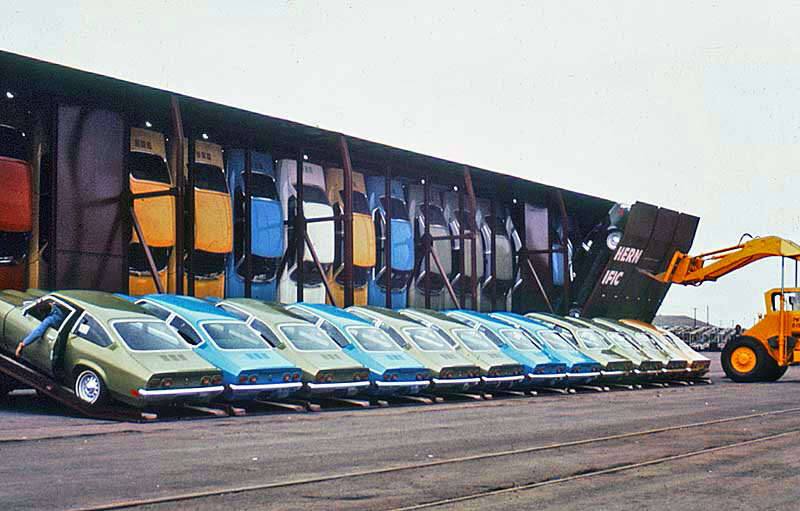
For this purpose several structural innovations have been made in the car. They include not only non-standard battery. To the client can go to the show room immediately, Veg-and shipped from the factory already tucked all the necessary liquids. In view of this need to change in the cooling and fuel systems, including carburetor design …
Despite this performance, which appeared «osportivlennuyu» version Gega GT and even a panel van, and the successful sale due to competent marketing company, the result was, to put it mildly, disappointing.
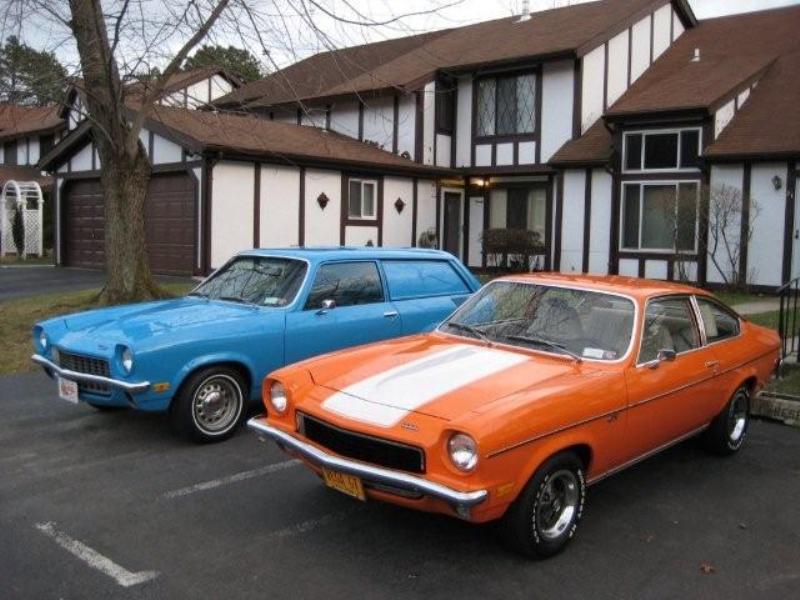
As a result, after the incredible loss of strikes, warranty replacement front fenders and many other components and assemblies, hundreds of structural improvement, including a review of half a million vehicles in 1972 to replace defective spindles, «sticky» throttle, and even the problems that led to fire, the car was discontinued in 1977. Total for 7 years (from 1971 to 1977-th) was issued more than two million Vega. At the same time according to some Vega GM did not bring any profit.
The so-called «wedding» — the combination of the body with the engine and transmission — carried by a large hydraulic jacks, while all other assembly lines used conveyors.
All this was done in order to achieve the release of 100 Vega … no, not in one day, and in one hour! In other words, every 36 seconds off the assembly line had to go to a brand new car. This is higher than exactly twice breakthrough performance in the world at that time. Already during the first few months it has been achieved in the figures 73,5 Vega hour. In part, the speed achieved using the fourth working rotation where it was necessary three — in one operation «extra» rested.
Soon conveyor closer to the coveted hundred. However, at 85 units per hour, began to have serious problems with the capacity of paint and paint shop.
However, together with the manufacturer DuPont, as well as changes in the structure of coloring nozzles produce a new quick-drying primer and paint, the problems were solved. But then again it affected the desire to save!
GM bosses not only strengthened discipline sinning at work, but after the change of management structure was abolished that same «fourth», reducing to 800 people. This leadership has accused the workers not only in slowing down the work, but even sabotage.

As a result, nearly 8000 workers in March 1972, went on strike, and not agreed with the unions, and spontaneous — so much they «get» the capitalists. The strike lasted for a month and cost GM twice more than the factory equipment — $ 150 million.
Only in 1975, the ninth year, when tempers finally settled, and with it structural defects have been eliminated, and increased production quality. It was only in the 5th year of production, it has finally reached a most cherished hundreds Vega to one hour, but, apparently — it was too late.
Reputation as a promising machine has been completely ruined, and competitors are not asleep, not to mention the imports, particularly the Japanese.
Not to mention, and that specifically for the Vega was designed and implemented in practice, unique in its kind dedicated vertical way to transport vehicles by rail. Instead of the maximum possible 18 units at the three-level method of loading in a car (also apply not so often), in this case in the same carriage Vert-A-Pac transported 30 cars at once.

For this purpose several structural innovations have been made in the car. They include not only non-standard battery. To the client can go to the show room immediately, Veg-and shipped from the factory already tucked all the necessary liquids. In view of this need to change in the cooling and fuel systems, including carburetor design …
Despite this performance, which appeared «osportivlennuyu» version Gega GT and even a panel van, and the successful sale due to competent marketing company, the result was, to put it mildly, disappointing.

As a result, after the incredible loss of strikes, warranty replacement front fenders and many other components and assemblies, hundreds of structural improvement, including a review of half a million vehicles in 1972 to replace defective spindles, «sticky» throttle, and even the problems that led to fire, the car was discontinued in 1977. Total for 7 years (from 1971 to 1977-th) was issued more than two million Vega. At the same time according to some Vega GM did not bring any profit.
Despite his reputation
As a result, the legacy of Vega — is tarnished reputation, not only GM’s, but also in the whole of the American automobile industry, at least — in terms of compact cars. Some even went further in their statements, saying that Vega has become a symbol of all the problems that were inherent in «Detroit» in the 70’s … However, despite all this, in a certain way in Vega appeared fans just in an environment of fast driving enthusiasts. For starters back to the engine.
The same aluminum 4-cylinder in the basic version developed only 90 hp L11 version with triple carburetor they were going up to 110, which at that time for a subcompact car was not so little.
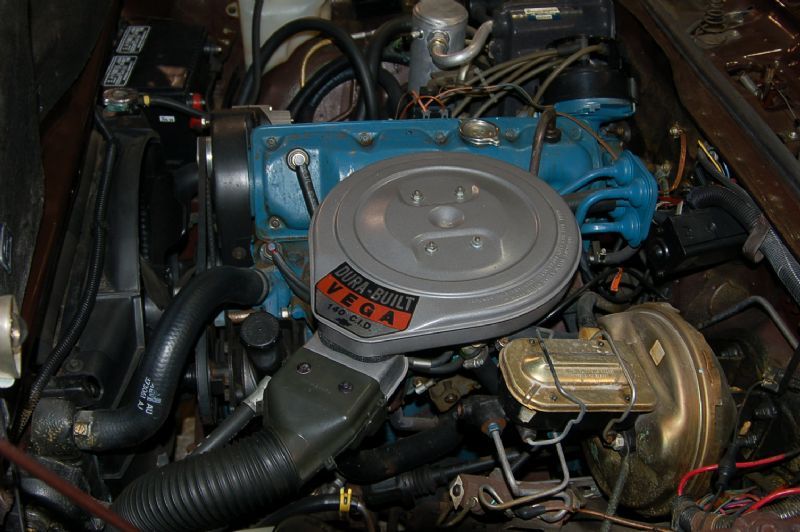
Torque in both versions was also quite decent for 2.3 liters — 164 Nm is reached at 2800 rpm.
Interestingly another. In the 72 th year of Hot Rod Magazine tested the experimental prototype Vega, equipped with a V8, and not simple.
The aluminum block was confined to the original volume of 283 inches (4.6 liters) to classic 302, or about 5 liters. He was fitted with forged pistons, crankshaft treated by Duntov, by custom inlet and outlet and the carburettor Quadrojet.
Equipped with a standard 3-speed transmission, the remaining drain the rest, and even booted into the road tires, that Vega on quarter stable output of 14 seconds.

Serial Vega the V8 naturally followed, but in the mid-70s, «Engin-swap» with a «resin-block» for the V8 Vega became quite common. Tom contributed to mass and availability of the machine. No joke, but under the influence of advertising, and the steadily rising prices for fuel, sales Veg-and at that point three times the Camaro. Soon, especially after it acquired the reputation of «Trouble-mobile» on the secondary market VEGA- «for pennies» enough.
Decades passed, and among fans of «Hot Hatch» Vega continued to enjoy steady popularity. Not the least role in this play and its appearance, especially front end.

It is very much like the Camaro, thus comparing favorably to the overall originality of the forms bored older sister for Chevy, as well as its direct competitors in the camp «muskl cars.» And that’s not to mention the meager price of b / y shnye the Vega, released two million copies, but the victim fiasco as an
The same aluminum 4-cylinder in the basic version developed only 90 hp L11 version with triple carburetor they were going up to 110, which at that time for a subcompact car was not so little.

Torque in both versions was also quite decent for 2.3 liters — 164 Nm is reached at 2800 rpm.
Interestingly another. In the 72 th year of Hot Rod Magazine tested the experimental prototype Vega, equipped with a V8, and not simple.
The aluminum block was confined to the original volume of 283 inches (4.6 liters) to classic 302, or about 5 liters. He was fitted with forged pistons, crankshaft treated by Duntov, by custom inlet and outlet and the carburettor Quadrojet.
Equipped with a standard 3-speed transmission, the remaining drain the rest, and even booted into the road tires, that Vega on quarter stable output of 14 seconds.

Serial Vega the V8 naturally followed, but in the mid-70s, «Engin-swap» with a «resin-block» for the V8 Vega became quite common. Tom contributed to mass and availability of the machine. No joke, but under the influence of advertising, and the steadily rising prices for fuel, sales Veg-and at that point three times the Camaro. Soon, especially after it acquired the reputation of «Trouble-mobile» on the secondary market VEGA- «for pennies» enough.
Decades passed, and among fans of «Hot Hatch» Vega continued to enjoy steady popularity. Not the least role in this play and its appearance, especially front end.

It is very much like the Camaro, thus comparing favorably to the overall originality of the forms bored older sister for Chevy, as well as its direct competitors in the camp «muskl cars.» And that’s not to mention the meager price of b / y shnye the Vega, released two million copies, but the victim fiasco as an
American subcompact …
Vega is also ideally suited to the base of the machine and a role for the drag strip. Easy compact coupe with a wheelbase of less than 2.5 meters — is not an option for a quick amateur drag-mobile?

The heroine of the story is easy to show times below 11 seconds, and for its rear slicks have already left more than 1800 starts at «kvotere». But let’s start at first, since the appearance of Paul Lowes this Vega also precarious, and even contradictory, as the history itself of this machine as a whole.
Future favorite Lowes just been found. Sometime in the mid-80s, somewhere (probably in California), it was stolen by someone who has something and then just thrown into the canyon near the town of North Park, near San Diego, where at that time Paul lived with his parents. Being a typical young American with gasoline in the blood, then I went to Lowes just on Camaro’74. He liked the «difficult teenager» (apparently it is unlikely someone was still needed, which is not surprising, if you read the beginning of the material), and he just towed it to the garage parental home.

It took another six years before Paul «got around» to this little girl, and he did not prevaricate — a couple of times it was visited by thoughts and not to throw it in a landfill there. Fortunately, he did exactly the opposite.

The heroine of the story is easy to show times below 11 seconds, and for its rear slicks have already left more than 1800 starts at «kvotere». But let’s start at first, since the appearance of Paul Lowes this Vega also precarious, and even contradictory, as the history itself of this machine as a whole.
Future favorite Lowes just been found. Sometime in the mid-80s, somewhere (probably in California), it was stolen by someone who has something and then just thrown into the canyon near the town of North Park, near San Diego, where at that time Paul lived with his parents. Being a typical young American with gasoline in the blood, then I went to Lowes just on Camaro’74. He liked the «difficult teenager» (apparently it is unlikely someone was still needed, which is not surprising, if you read the beginning of the material), and he just towed it to the garage parental home.

It took another six years before Paul «got around» to this little girl, and he did not prevaricate — a couple of times it was visited by thoughts and not to throw it in a landfill there. Fortunately, he did exactly the opposite.
Second Life
Already matured Lowes took the path of least resistance, and in all areas, including the economy. He did not «mess around» with the engine ready in acquiring a trusted mechanic. They became a classic 350-cc engine (5.7 liters), though not new, but the last Rebild with boring at 0.030. It was a classic steel crankshaft from the 70s, and were installed classic GM «pink rods».
This is a really painted pink lightweight connecting rods, which were originally intended for engines Z / 28 and LT1. Their production also began long ago, in the late 60’s, and they had a lot of tricks, including babbitovye with lead ends.
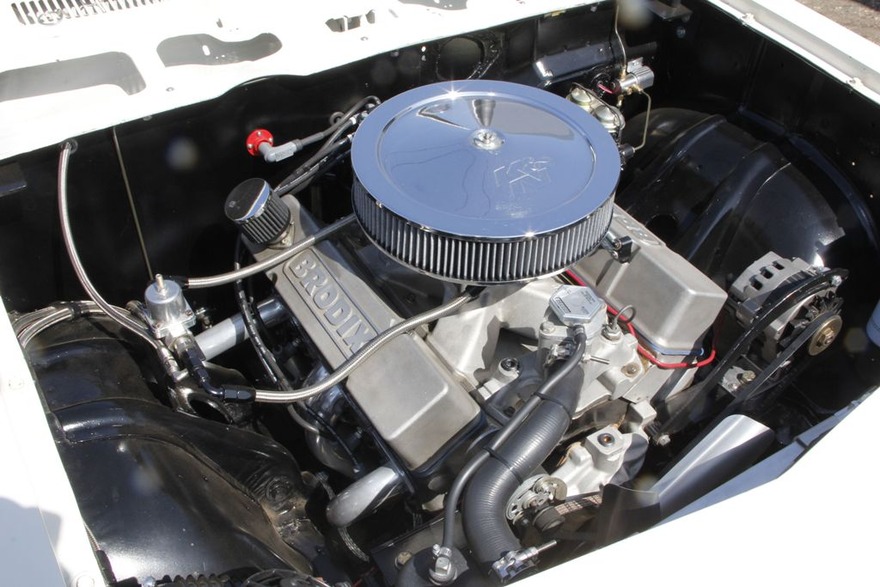
The block set head Brodix Track 1. At the time they were made specifically for the engines used in the racing oval and drag strip. They are somewhat lighter than standard, while the base is made of a fairly massive that aligns well with the use of nitrous oxide. Runners made of fosforitsidnoy bronze, while the «seat» of the flaps are further compacted.
The top of the combustion chamber in these heads are further processed on CNC machines (CNC). They also treated the inlet and outlet channels.
The data heads are low cost and does not require any special components, allowing them a maximum of serial parts. The same applies to the intake and exhaust systems. Nevertheless, the engine is not used serial nodes: camshafts from Crower, Team G intake and Holley carburetor 850.
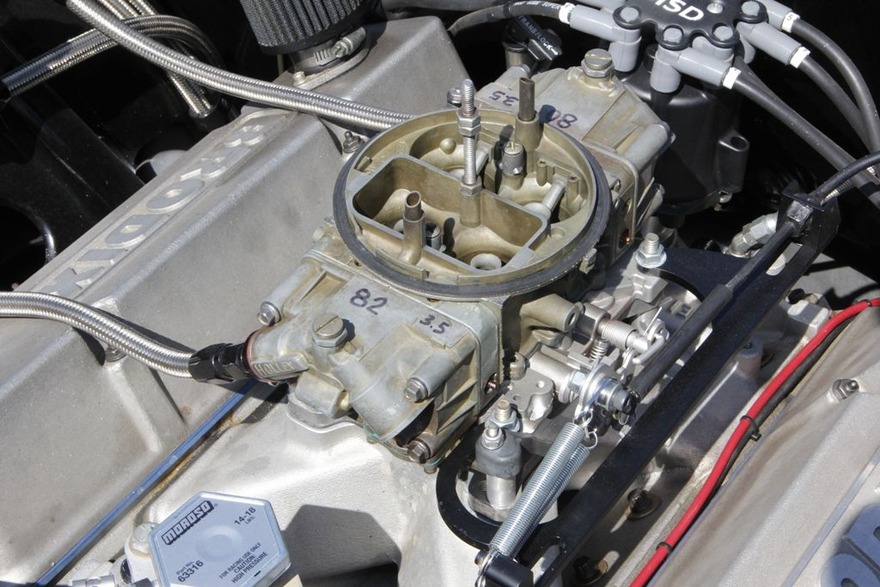
Compression has grown to a fairly respectable 11.1:1. The machine used MSD 6AL ignition distributor 8555 of the same firm. At the same time on the rollcage tube hiding volt meter.

As transmission is selected PPC Powerglide with a ratio of the first transmission of 1.82: 1, 1-A converter with an intermediate braking, which is activated by 4.5 thousand revolutions. «Diff» — 9 dyuymovik from Currie with a ratio of 4.56:1. As the switch is naturally used Hurst Quarterstick.
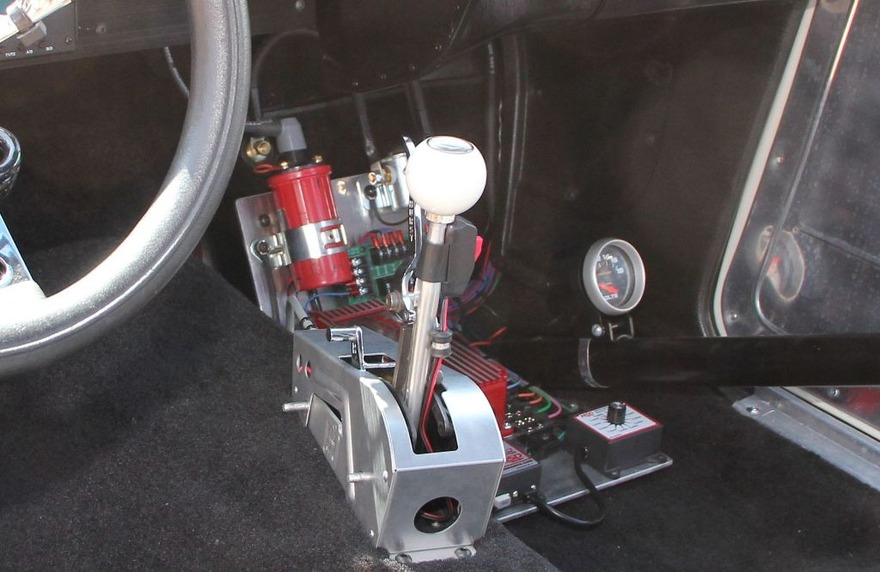
The most interesting thing is that the rest of the Vega remained almost sink with only a couple of improvements. For example, the rear were equipped with special homemade «clicking» traction help at sharp start from a place not «sag» springs rear axle, while the front suspension remained entirely serial.
This is a really painted pink lightweight connecting rods, which were originally intended for engines Z / 28 and LT1. Their production also began long ago, in the late 60’s, and they had a lot of tricks, including babbitovye with lead ends.

The block set head Brodix Track 1. At the time they were made specifically for the engines used in the racing oval and drag strip. They are somewhat lighter than standard, while the base is made of a fairly massive that aligns well with the use of nitrous oxide. Runners made of fosforitsidnoy bronze, while the «seat» of the flaps are further compacted.
The top of the combustion chamber in these heads are further processed on CNC machines (CNC). They also treated the inlet and outlet channels.
The data heads are low cost and does not require any special components, allowing them a maximum of serial parts. The same applies to the intake and exhaust systems. Nevertheless, the engine is not used serial nodes: camshafts from Crower, Team G intake and Holley carburetor 850.

Compression has grown to a fairly respectable 11.1:1. The machine used MSD 6AL ignition distributor 8555 of the same firm. At the same time on the rollcage tube hiding volt meter.

As transmission is selected PPC Powerglide with a ratio of the first transmission of 1.82: 1, 1-A converter with an intermediate braking, which is activated by 4.5 thousand revolutions. «Diff» — 9 dyuymovik from Currie with a ratio of 4.56:1. As the switch is naturally used Hurst Quarterstick.

The most interesting thing is that the rest of the Vega remained almost sink with only a couple of improvements. For example, the rear were equipped with special homemade «clicking» traction help at sharp start from a place not «sag» springs rear axle, while the front suspension remained entirely serial.
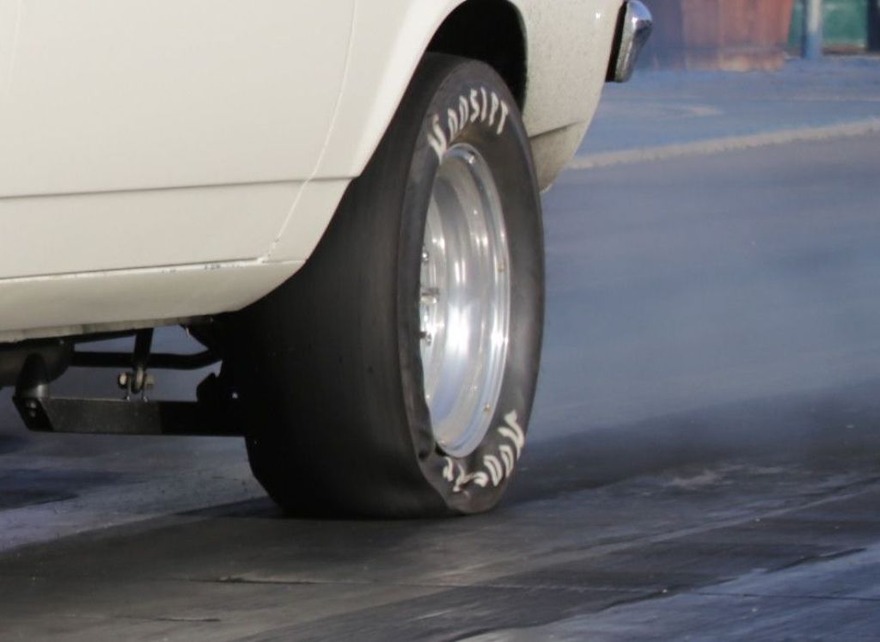
Front as a «thin persons» used wheels 15h4 Weld Draglites, while behind 15h8 disks of the same company are dressed dregovye «rollers» 26.0 / 9.0–15. Naturally «tires» from Hoosier.
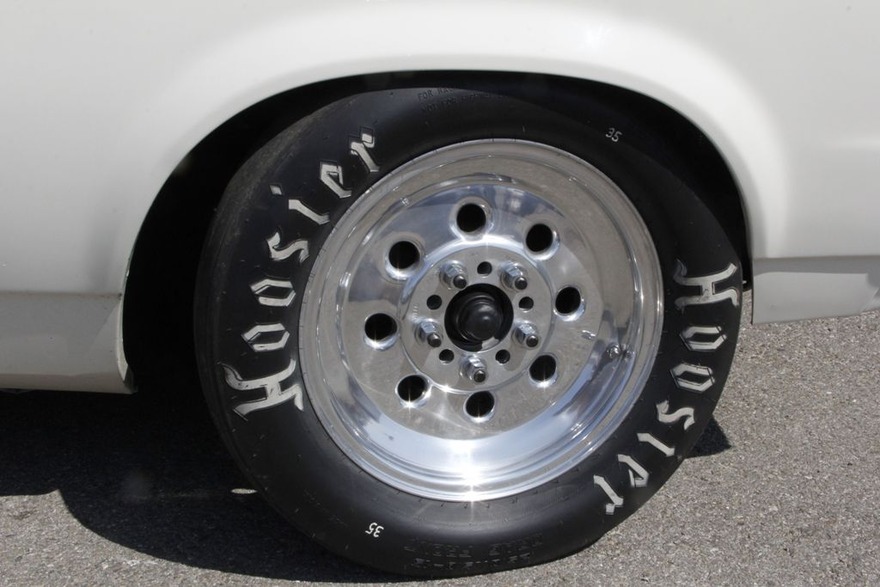

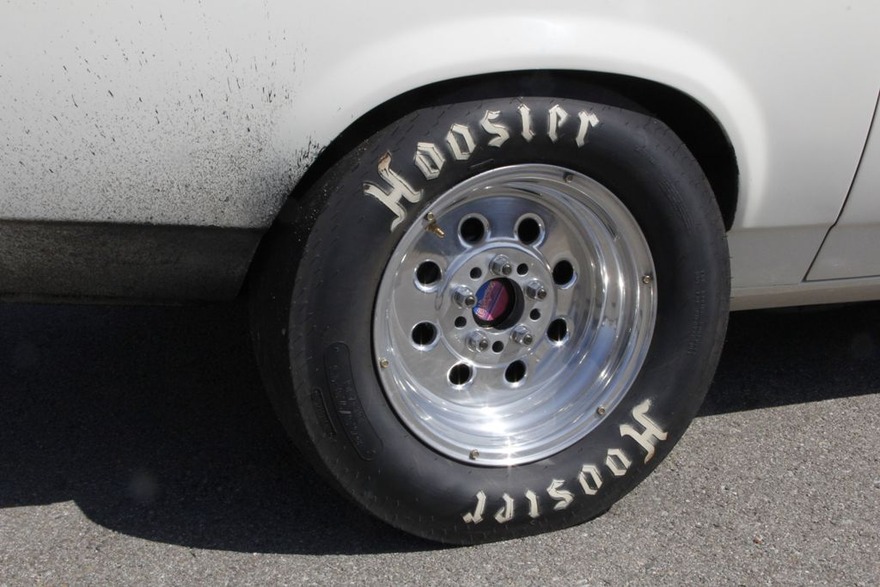
In addition to the actual engine and exhaust, all other Lowes improvements done personally. «Exhaust» is engaged in the office of Scott Keyes JBA from San Diego. The basis they have «spiders» Hooker Super Comp, by custom nozzles finished her «Glushakov» Flowmaster 20 Series.
Painting Paul worked with his own, without becoming its Vega decorate any bright colors and decorations in the form of a flame, leaving it deliberately white. It is understandable — Lowes originally conceived his Vega does not as bright car show, namely the car for competition.
Go!
Thanks to this converter Vega starts at 5000 rpm, while switching to a higher 7.2. If the original model 72 Stock-year weighed a little more than one ton (to be exact — 1005 kg), this somewhat recovered to nearly 1200 kg. However, if you remember that instead of a lightweight aluminum 4-tsillidnrovika it was established fairly archaic V8 and a new transmission, as well as all of the security system, including not easy «roll-cage», the weight gain in the realities of Misery.
Diet includes fayberglassovye hood and front wings, plus some other tricks like the most lightweight interior.
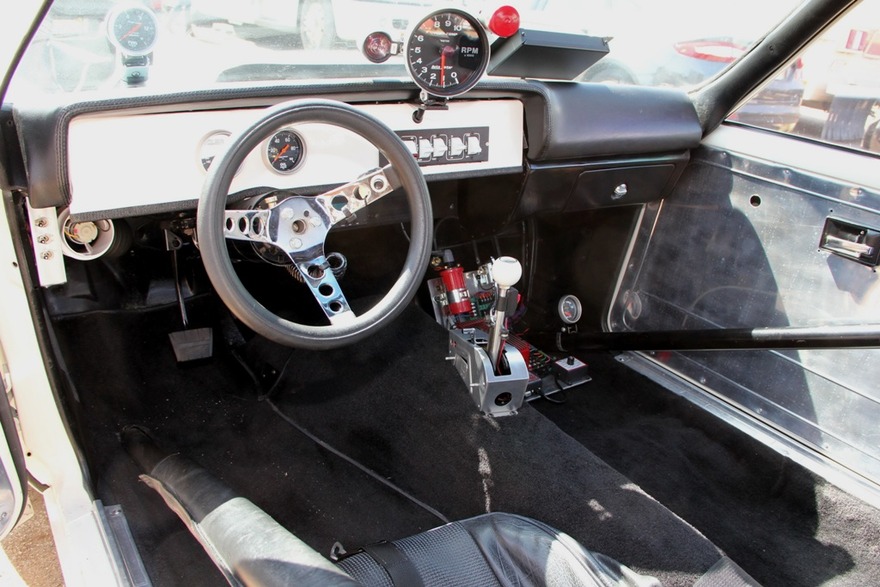
Actually he was quite austere and simple in execution «no frills» — again, in front of us is dregovaya machine, which is also to do with the «budget in mind …»
Seasoned racing gasoline with an octane rating of 110, this goes to Vega «kvotere» of 11 seconds, approaching 10, but Paul still often prefers to stay in the area 11 seconds, speaking in the usual for such participants Index of so-called races.
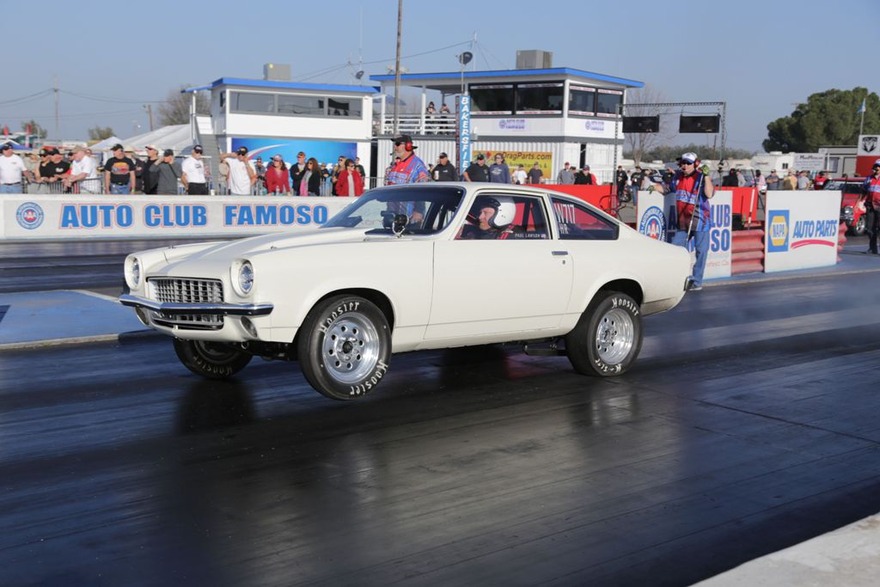
They represent a usual start of «side-by-side» at the same time two cars, and all — regardless of weight or engine. In reality both parties have nothing to do at the finish line to exceed their pre-designated time-code for the passage of the «Quarter» — usually 10, 11 or 12.5 seconds. In the case of less time, even a thousandth, victory goes to the opponent.

In other words, in these races to win the reality is not necessarily the one who was the first to reach the finish line, as here at the same time, participants can start, for which the time- «index» can be, and 12.5 and 10 seconds. But viewers get competitive effects, as well as the participants themselves. At the same time for greater entertainment starting with a handicap can be given to the difference «index».
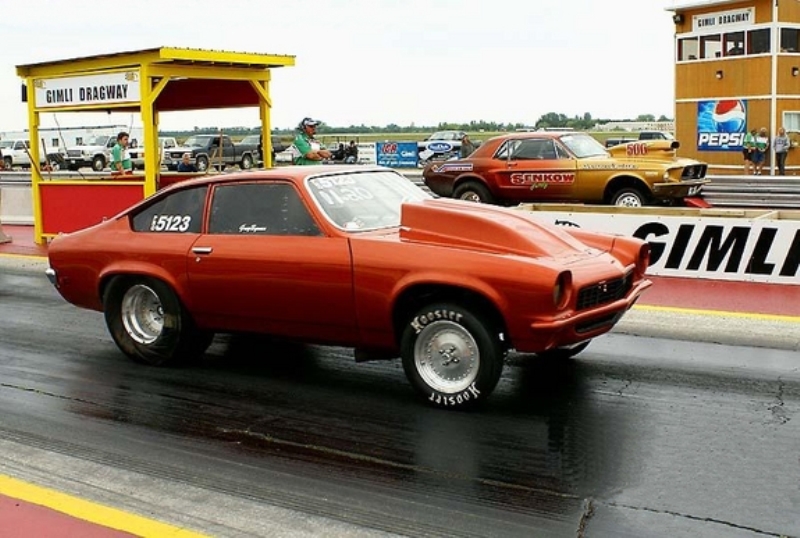
However, Lowes involved in classical classrooms Pro and the Super Pro, which to his credit, as well as in the Index, there is a lot of victories.
Interestingly, the assurances of Paul, from the initial assembly of the engine, its Vega came out at the start of more than 1,800 times and has never failed. The only thing that has been done since 1996, the year, so it is replaced with double rings and bearings of the engine and all moving parts.

You can be sure that for a long time surpassing the barrier of 40 years, Lowes will display at the start of her favorite still not one hundred or even a thousand times …
Paul himself says he chose the Vega «the fault» of his youth, friends, that in those days it used low-Veg and to build «hot hatch» to drive them on the evening streets. In contrast, Paul Lowes, like many others of his Odnodum, went much further and more professional.
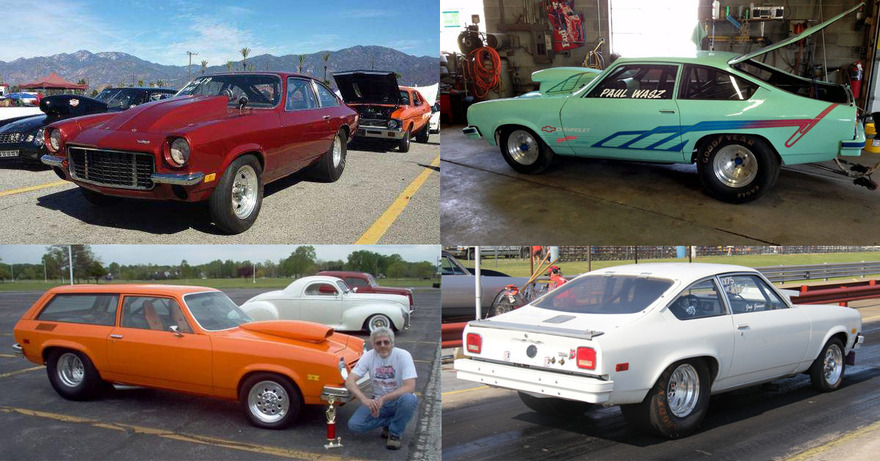
And his passion lasted for many years, becoming a true partnership for decades … Thanks to these fans of «hot hatch» as Lowes, you can be sure that the name Vega will live a very long time, at least on the drag strips …
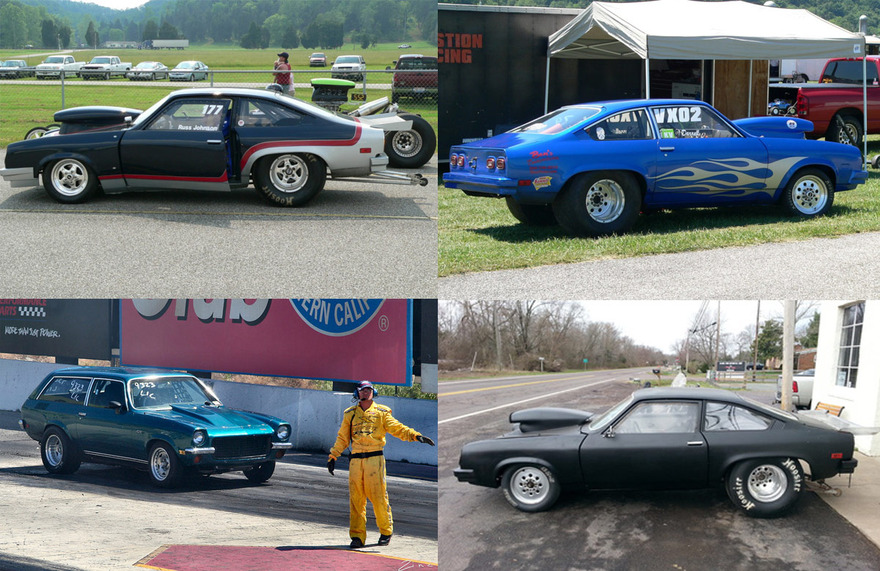
Photo: open source
Diet includes fayberglassovye hood and front wings, plus some other tricks like the most lightweight interior.

Actually he was quite austere and simple in execution «no frills» — again, in front of us is dregovaya machine, which is also to do with the «budget in mind …»
Seasoned racing gasoline with an octane rating of 110, this goes to Vega «kvotere» of 11 seconds, approaching 10, but Paul still often prefers to stay in the area 11 seconds, speaking in the usual for such participants Index of so-called races.

They represent a usual start of «side-by-side» at the same time two cars, and all — regardless of weight or engine. In reality both parties have nothing to do at the finish line to exceed their pre-designated time-code for the passage of the «Quarter» — usually 10, 11 or 12.5 seconds. In the case of less time, even a thousandth, victory goes to the opponent.

In other words, in these races to win the reality is not necessarily the one who was the first to reach the finish line, as here at the same time, participants can start, for which the time- «index» can be, and 12.5 and 10 seconds. But viewers get competitive effects, as well as the participants themselves. At the same time for greater entertainment starting with a handicap can be given to the difference «index».

However, Lowes involved in classical classrooms Pro and the Super Pro, which to his credit, as well as in the Index, there is a lot of victories.
Interestingly, the assurances of Paul, from the initial assembly of the engine, its Vega came out at the start of more than 1,800 times and has never failed. The only thing that has been done since 1996, the year, so it is replaced with double rings and bearings of the engine and all moving parts.

You can be sure that for a long time surpassing the barrier of 40 years, Lowes will display at the start of her favorite still not one hundred or even a thousand times …
Paul himself says he chose the Vega «the fault» of his youth, friends, that in those days it used low-Veg and to build «hot hatch» to drive them on the evening streets. In contrast, Paul Lowes, like many others of his Odnodum, went much further and more professional.

And his passion lasted for many years, becoming a true partnership for decades … Thanks to these fans of «hot hatch» as Lowes, you can be sure that the name Vega will live a very long time, at least on the drag strips …

Photo: open source









